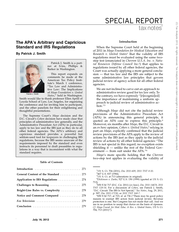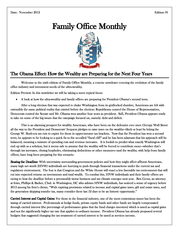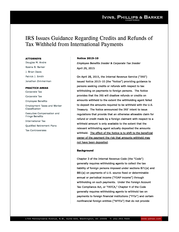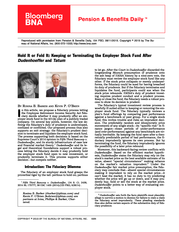Hold It or Fold It: Keeping or Terminating the Employer Stock Fund After Dudenhoeffer and Tatum – August 11, 2015
Ivins, Phillips & Barker, Chartered
Description
21
this approach, no matter how sound, given the still
sparse and inconsistent case law. Applying its permitted discretion to draw lines, the fiduciary can, with the
assistance of a financial consultant, investigate whether
the stock’s degree of volatility falls below some upper
limit, selected by the fiduciary.
(e) The fiduciary’s duty of prudence is somewhat ill
defined on key points. And while a process can establish a decision is prudent, possibly no process can help
the fiduciary with respect to all its ERISA duties, all
supplying multiple potential claims of breach, and all
somewhat shifting and imprecisely defined.
(2) Terminating the Fund. The fiduciary might accordingly prefer to terminate the fund and liquidate the
stock.
We have proposed a process allowing the fiduciary to establish that the termination is prudent and solely in the participants’ interests—even if the stock price later goes up—without simultaneously signaling that management has lost faith in the stock, that the fiduciary was imprudent not to close it earlier, or that the fiduciary terminated the fund for inappropriate and disloyal reasons. (a) The fiduciary’s starting point when terminating the fund is the same as when deciding to hold it open. By applying a test based on the Cammer/Krogman factors, the fiduciary can show the stock trades in an efficient market. The fiduciary thus establishes by a prudent process that no special circumstances make it imprudent to rely on the stock’s market price as the best available estimate of its value. No matter how good (or bad) the stock’s recent price performance, optimistic the press or bullish the analysts, the fiduciary can prudently conclude it has no ability to outguess the market, and so no duty to predict or even try to predict the stock’s future price.
It is not imprudent to sell at the market price. (b) The fiduciary’s next step is to show the termination promotes the plan’s purpose of enabling retirement savings, by showing the termination eliminates uncompensated risk—risk participants assume without being paid more to do so—created by the nondiversified employer stock fund. To do this, the fiduciary may commission a ‘‘volatility study,’’ which should show the employer stock fund is more volatile than the plan’s other, diversified funds. Based on this study, the fiduciary may conclude that the single-stock fund contributes to uncompensated risk and frustrates the plan’s purpose of providing adequate retirement savings relative to the plan’s other funds. (c) This volatility study also provides several permitted incidental benefits to the fiduciary and the company.
The process allows the company to explain the fund’s termination to its employees and shareholders in a way clearly showing that management has not lost faith in the company’s stock, or acted on the basis of concealed business troubles. The company can explain, and the fiduciary record will show, the decision was made by the fiduciary based solely on the fiduciary’s concerns about the uncompensated risk created by the nondiversified employer stock fund, and the fiduciary’s ISSN conclusion the fund was less appropriate for a retirement plan than the plan’s other, diversified funds. (d) The volatility study also allows the fiduciary to terminate the fund without admitting or supplying evidence it was imprudent to keep it open before. Under ERISA, the fiduciary is permitted to ignore the employer stock fund’s lack of diversification in evaluating its prudence.
But it is not required to do so. And under ERISA the fiduciary enjoys flexibility in determining the plan’s prudent investment strategy. The fiduciary should not be held imprudent for using its discretion to investigate a potential impediment to the plan’s purpose that by law the fiduciary was permitted to ignore.
And by demonstrating the decision promotes the plan’s purpose of retirement savings, the fiduciary demonstrates the decision is both prudent and consistent with its duty of loyalty to act solely in participants’ interests. If any internal evidence is revealed showing the fiduciary also wished to eliminate an ongoing source of liability, the process should show this objective is merely a permitted incidental benefit. An example of a volatility study conducted for the employer stock fund of an unnamed company can be found on the website of NERA Economic Consultants.117 (e) Whether a plan amendment commanding termination of the fund helps or hurts is a close call. After Dudenhoeffer, it is an open question whether an amendment places a thumb on the ‘‘prudence’’ side of the scale.
There is a non-trivial risk the plan amendment will itself be viewed as a fiduciary rather than settlor act, meaning the need for process is not avoided. And both employer and fiduciary might prefer a process establishing a prudent basis for the termination and allowing a true and credible public explanation unrelated to the company’s health or the fiduciary’s concerns about its own liability. (f) The appropriate role of any independent fiduciary is also an issue. An independent fiduciary accustomed to handling employer stock sales can bring valuable expertise to a complex process. But it is very unclear whether the independent fiduciary relieves corporate insider fiduciaries from the hazards of holding inside information. (3) Shoring Up Fiduciary’s 404(c) Protection. In addition, the fiduciary who wants to keep the fund open may wish participants who choose to invest in the employer stock fund assume at least some responsibility for the decision.
The fiduciary could obtain express participant consent for each stock fund purchase. Another idea would have the participants who elect to invest in the company stock fund denominated as ‘‘named fiduciaries’’ with respect to the company stock fund offering. While rather speculative, these could be used as ancillary strategies. 117 See ‘‘NERA’s Review of Fortune 500 Company’s Employee Stock Ownership Plan’’ http://www.nera.com/ publications/archive/case-project-experience/nera-s-review-offortune-500-company-s-employee-stock-ownership-.html. BNA 8-11-15 .
We have proposed a process allowing the fiduciary to establish that the termination is prudent and solely in the participants’ interests—even if the stock price later goes up—without simultaneously signaling that management has lost faith in the stock, that the fiduciary was imprudent not to close it earlier, or that the fiduciary terminated the fund for inappropriate and disloyal reasons. (a) The fiduciary’s starting point when terminating the fund is the same as when deciding to hold it open. By applying a test based on the Cammer/Krogman factors, the fiduciary can show the stock trades in an efficient market. The fiduciary thus establishes by a prudent process that no special circumstances make it imprudent to rely on the stock’s market price as the best available estimate of its value. No matter how good (or bad) the stock’s recent price performance, optimistic the press or bullish the analysts, the fiduciary can prudently conclude it has no ability to outguess the market, and so no duty to predict or even try to predict the stock’s future price.
It is not imprudent to sell at the market price. (b) The fiduciary’s next step is to show the termination promotes the plan’s purpose of enabling retirement savings, by showing the termination eliminates uncompensated risk—risk participants assume without being paid more to do so—created by the nondiversified employer stock fund. To do this, the fiduciary may commission a ‘‘volatility study,’’ which should show the employer stock fund is more volatile than the plan’s other, diversified funds. Based on this study, the fiduciary may conclude that the single-stock fund contributes to uncompensated risk and frustrates the plan’s purpose of providing adequate retirement savings relative to the plan’s other funds. (c) This volatility study also provides several permitted incidental benefits to the fiduciary and the company.
The process allows the company to explain the fund’s termination to its employees and shareholders in a way clearly showing that management has not lost faith in the company’s stock, or acted on the basis of concealed business troubles. The company can explain, and the fiduciary record will show, the decision was made by the fiduciary based solely on the fiduciary’s concerns about the uncompensated risk created by the nondiversified employer stock fund, and the fiduciary’s ISSN conclusion the fund was less appropriate for a retirement plan than the plan’s other, diversified funds. (d) The volatility study also allows the fiduciary to terminate the fund without admitting or supplying evidence it was imprudent to keep it open before. Under ERISA, the fiduciary is permitted to ignore the employer stock fund’s lack of diversification in evaluating its prudence.
But it is not required to do so. And under ERISA the fiduciary enjoys flexibility in determining the plan’s prudent investment strategy. The fiduciary should not be held imprudent for using its discretion to investigate a potential impediment to the plan’s purpose that by law the fiduciary was permitted to ignore.
And by demonstrating the decision promotes the plan’s purpose of retirement savings, the fiduciary demonstrates the decision is both prudent and consistent with its duty of loyalty to act solely in participants’ interests. If any internal evidence is revealed showing the fiduciary also wished to eliminate an ongoing source of liability, the process should show this objective is merely a permitted incidental benefit. An example of a volatility study conducted for the employer stock fund of an unnamed company can be found on the website of NERA Economic Consultants.117 (e) Whether a plan amendment commanding termination of the fund helps or hurts is a close call. After Dudenhoeffer, it is an open question whether an amendment places a thumb on the ‘‘prudence’’ side of the scale.
There is a non-trivial risk the plan amendment will itself be viewed as a fiduciary rather than settlor act, meaning the need for process is not avoided. And both employer and fiduciary might prefer a process establishing a prudent basis for the termination and allowing a true and credible public explanation unrelated to the company’s health or the fiduciary’s concerns about its own liability. (f) The appropriate role of any independent fiduciary is also an issue. An independent fiduciary accustomed to handling employer stock sales can bring valuable expertise to a complex process. But it is very unclear whether the independent fiduciary relieves corporate insider fiduciaries from the hazards of holding inside information. (3) Shoring Up Fiduciary’s 404(c) Protection. In addition, the fiduciary who wants to keep the fund open may wish participants who choose to invest in the employer stock fund assume at least some responsibility for the decision.
The fiduciary could obtain express participant consent for each stock fund purchase. Another idea would have the participants who elect to invest in the company stock fund denominated as ‘‘named fiduciaries’’ with respect to the company stock fund offering. While rather speculative, these could be used as ancillary strategies. 117 See ‘‘NERA’s Review of Fortune 500 Company’s Employee Stock Ownership Plan’’ http://www.nera.com/ publications/archive/case-project-experience/nera-s-review-offortune-500-company-s-employee-stock-ownership-.html. BNA 8-11-15 .
Investor Relations Presentations
+
Investor Relations Sub Categories
Ivins, Phillips & Barker, Chartered









